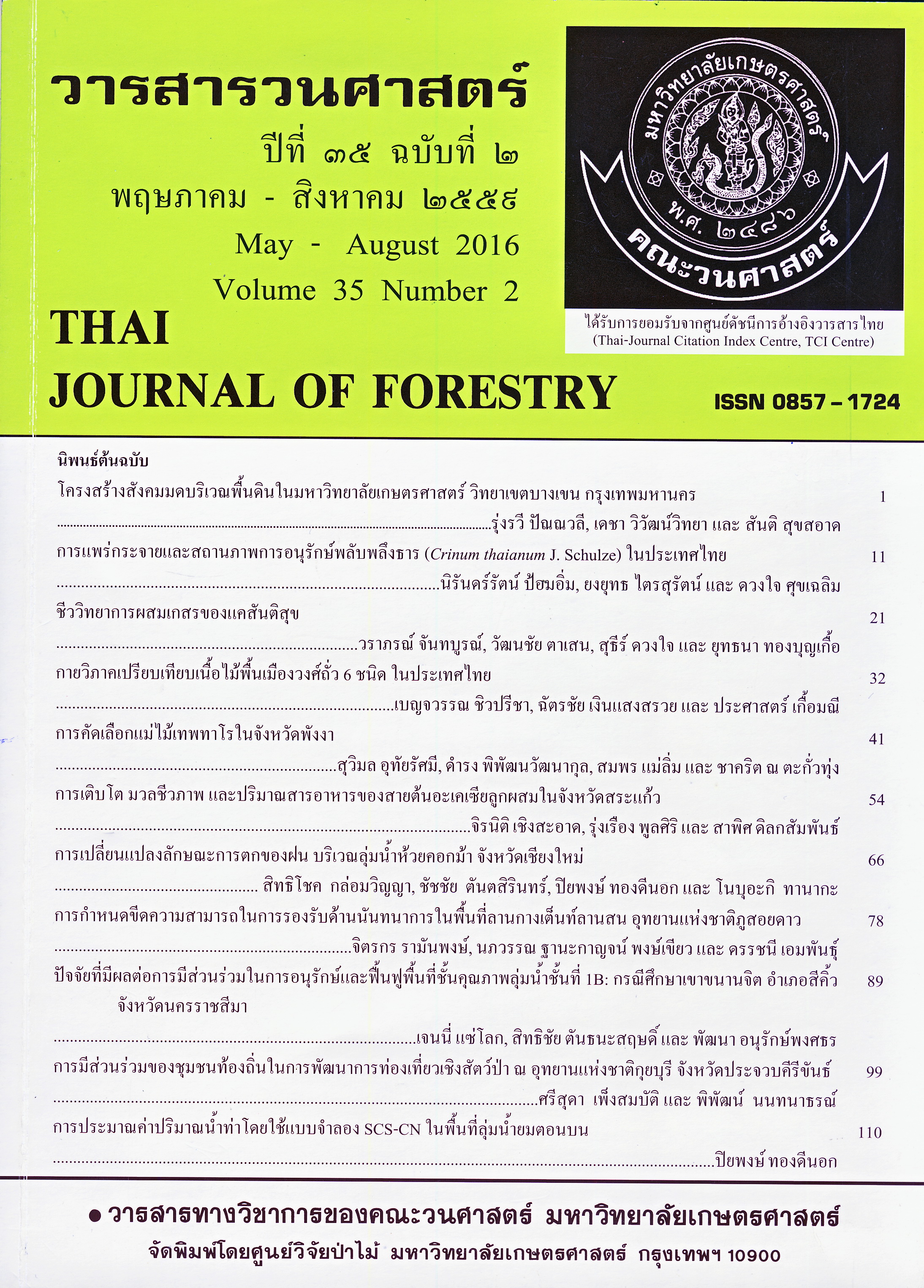โครงสร้างสังคมมดบริเวณพื้นดิน ในมหาวิทยาลัยเกษตรศาสตร์ วิทยาเขตบางเขน กรุงเทพมหานคร
Main Article Content
บทคัดย่อ
การศึกษาโครงสร้างทางสังคมมดบริเวณพื้นดินในมหาวิทยาลัยเกษตรศาสตร์ วิทยาเขตบางเขน กรุงเทพมหานคร ช่วงฤดูแล้งระหว่างเดือนมีนาคม-เมษายน พ.ศ. 2557 และช่วงฤดูฝนระหว่างเดือนกรกฎาคม-สิงหาคม พ.ศ. 2557 เพื่อทราบค่าดัชนีความหลากหลาย ค่าดัชนีความสม่ำเสมอ ค่าความคล้ายคลึง การกระจาย การปรากฏ และผลกระทบจากมด เพื่อนำไปบริหารจัดการการใช้ประโยชน์พื้นที่ต่างๆ ให้นำไปสู่การลดอันตรายจากมดหรือลดการสร้างปัญหาจากมดลงได้อย่างมีประสิทธิภาพ โดยทำการเลือกพื้นที่ 5 ประเภทพื้นที่การใช้ประโยชน์ในรูปแบบต่างๆ ของมนุษย์ ประกอบด้วย พื้นที่รอบอาคาร พื้นที่โรงอาหาร พื้นที่สนามหญ้า พื้นที่ต้นไม้ใหญ่ และพื้นที่คอนกรีต โดยแต่ละพื้นที่ทำการวางเหยื่อ 2 แนวเส้นสำรวจ คือเหยื่อน้ำหวาน 20 เหยื่อ และเหยื่อทูน่า 20 เหยื่อ วางเหยื่อทิ้งไว้ 30 นาที แล้วบันทึกจำนวนตัวและชนิดของมดในแต่ละพื้นที่ ทำการเก็บตัวอย่างทุกๆ 2 สัปดาห์ เป็นระยะเวลา 4 เดือน
ผลการศึกษาพบว่าพบมดทั้งหมด 9 ชนิด 9 สกุล 4 วงศ์ย่อย ค่าดัชนีความหลากหลาย (1.23) และค่าดัชนีความสม่ำเสมอ (0.44) สูงที่สุด คือ พื้นที่รอบตัวอาคาร ค่าดัชนีความคล้ายคลึงมากที่สุด คือ 100 เปอร์เซ็นต์ ประกอบด้วย พื้นที่รอบตัวอาคาร 1, พื้นที่รอบตัวอาคาร 2, พื้นที่โรงอาหาร และพื้นที่คอนกรีต การจัดกลุ่มมดโดยใช้ชนิดมด โดยนำมาวิเคราะห์ Cluster Analysis เมื่อพิจารณาที่ระดับ 80 เปอร์เซ็นต์ แบ่งออกได้ 3 กลุ่ม ดังนี้ กลุ่ม 1 ได้แก่ พื้นที่รอบตัวอาคาร พื้นที่โรงอาหาร และพื้นที่คอนกรีต กลุ่ม 2 ได้แก่ พื้นที่รอบตัวอาคาร พื้นที่ต้นไม้ใหญ่ พื้นที่สนามหญ้า และกลุ่ม 3 ได้แก่ พื้นที่สนามหญ้าและพื้นที่ต้นไม้ใหญ่ ชนิดมดที่กระจายได้ดีที่สุด คือ Paratrechina longicornis มีการปรากฏทั้งฤดูฝนและฤดูแล้ง ตลอดทั้งเดือน พื้นที่รอบตัวอาคารมีค่าความมากมายของมดสูงที่สุด ชนิดมดที่สำคัญที่สุดที่ส่งผลผลกระทบต่อมนุษย์ ด้านสุขภาพและด้านสร้างความรำคาญ คือ Solenopsis geminata, Paratrechina longicornis และ Tapinoma melanocephalum ทั้ง 3 ชนิดพบได้ทั้งฤดูแล้งและฤดูฝนหรือตลอดทั้งเดือน ดังนั้นการใช้ประโยชน์พื้นที่ของมนุษย์ทั้ง 5 พื้นที่มีผลต่อความมากมายของมดเท่านั้นและสามารถประเมินได้ว่าพื้นที่รอบอาคาร 2 เป็นพื้นที่อันตรายของมหาวิทยาลัยเกษตรศาสตร์
Downloads
Article Details
ข้าพเจ้าและผู้เขียนร่วม (ถ้ามี) ขอรับรองว่า ต้นฉบับที่เสนอมานี้ยังไม่เคยได้รับการตีพิมพ์และไม่ได้อยู่ในระหว่างกระบวนการพิจารณาตีพิมพ์ลงในวารสารหรือสิ่งตีพิมพ์อื่นใด ข้าพเจ้าและผู้เขียนร่วม (ถ้ามี) ยอมรับหลักเกณฑ์และเงื่อนไขการพิจารณาต้นฉบับ ทั้งยินยอมให้กองบรรณาธิการมีสิทธิ์พิจารณาและตรวจแก้ต้นฉบับได้ตามที่เห็นสมควร พร้อมนี้ขอมอบลิขสิทธิ์ผลงานที่ได้รับการตีพิมพ์ให้แก่วารสารวนศาสตร์ คณะวนศาสตร์ มหาวิทยาลัยเกษตรศาสตร์ กรณีมีการฟ้องร้องเรื่องการละเมิดลิขสิทธิ์เกี่ยวกับภาพ กราฟ ข้อความส่วนใดส่วนหนึ่ง หรือ ข้อคิดเห็นที่ปรากฏในผลงาน ให้เป็นความรับผิดชอบของข้าพเจ้าและผู้เขียนร่วม (ถ้ามี) แต่เพียงฝ่ายเดียว และหากข้าพเจ้าและผู้เขียนร่วม (ถ้ามี) ประสงค์ถอนบทความในระหว่างกระบวนการพิจารณาของทางวารสาร ข้าพเจ้าและผู้เขียนร่วม (ถ้ามี) ยินดีรับผิดชอบค่าใช้จ่ายทั้งหมดที่เกิดขึ้นในกระบวนการพิจารณาบทความนั้น”
เอกสารอ้างอิง
Herbers, J.M. 1985. Seasonal Structing of a North Temperature and Communities. Insect Sociaux 32: 224-240.
Holldobler, B. and E.O. Wilson. 1990. the The Ants. The Belknap Press of Harvard University Press, Cambridge, London.
Jaitrong, W. 2001. Identification guide to the ant genera of Khao Yai National Park. Department of Forest Biology Faculty of Forestry Kasetsart University, Bangkok. (in Thai)
Jaitrong, W. 2011. Manual classification currency ants in Thailand. National Science Museum, Ministry of science and Technology, Pathumthani. (in Thai)
Krebs, J.C. 1972. Ecology: The Experimental Analysis of Distribution and Abundance. Harper and Row Publishers, New York.
Krebs, J.C. 1999. Ecological methodology. Vol. 620. Benjamin/Cummings, Menlo Park, California.
Ludwig, J.A. and J.F. Reynolds. 1988. Statistical Ecology. John Wiley & Sons, New York. Academy Press, Washington, D.C. 297 p.
McCune, B. and M.J. Mefford. 1999. PC-ORD. Multivariate Analysis of Ecological Data Version 4. MjM Solfware Design, Glenden.
Senthong, D. 2003. Ant Distribution Based on Air Quality Variation in Urban Community of Bangkok. M.S. Thesis, Kasetsart Universtiy, Bangkok. (in Thai)
Songtummin, R. 2014. Ant Bite Big Problem. Available source: http://www.healthandcuisine.com/detail.aspx?ID=6001#.VCR5NmeSw4N, August 1, 2014. (in Thai)
Sorensen, B. 1984. Physical Measurement as Risk Indicators for Low-Back Trouble Over a One Year Period. Journal of Spinal Disorders and Techniques 9: 106-119.
Srihakom, W. 2013. The Community Structure and Species Composition of Ground-dwelling Ants in Various Land Uses among Urban Parks in Bangkok. M.S. Thesis, Kasetsart University, Bangkok. (in Thai)
Wilson, E.O. 2000. Standard Methods for Measuring and Monitoring Biodiversity. Smithsonian Institution Press, Washington.
Wiwatwitaya, D. and H. Takeda. 2005. Seasonal changes in soil arthropod abundance in the dry evergreen forest of north-east Thailand, with special reference to collembolan communities. Ecological Research 20 (1): 59-70.


